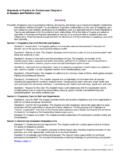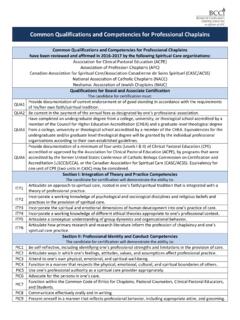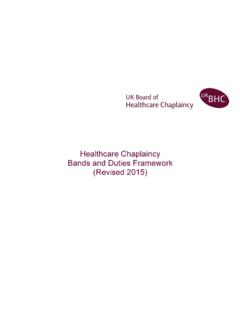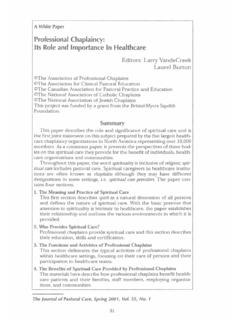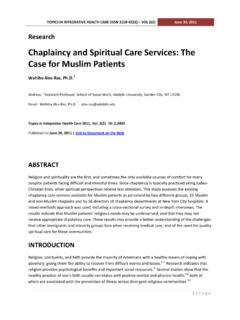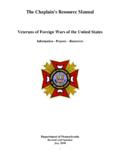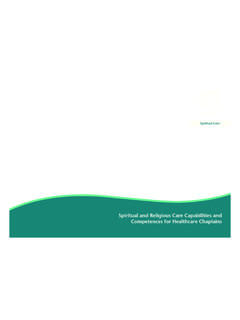Transcription of Standards of Practice for Professional Chaplains in …
1 Standards of Practice for Professional Chaplains in Acute Care |1 Standards of Practice for Professional Chaplains in Acute Care Settings INTRODUCTION Preamble: chaplaincy care is grounded in initiating, developing and deepening, and bringing to an appropriate close, a mutual and empathic relationship with the patient, family, and/ or staff. The development of a genuine relationship is at the core of chaplaincy care and underpins, even enables, all the other dimensions of chaplaincy care to occur. It is assumed that all of the Standards are addressed within the context of such Section 1: chaplaincy Care with Patients and Families Standard 1, Assessment: The chaplain gathers and evaluates relevant data pertinent to the patient s situation and/or bio-psycho-social-spiritual/religious health. Standard 2, Delivery of Care: The chaplain develops and implements a plan of care to promote patient well-being and continuity of care.
2 Standard 3, Documentation of Care: The chaplain enters information into the patient s medical record that is relevant to the patient s medical, psycho-social, and spiritual/religious goals of care. Standard 4, Teamwork and Collaboration: The chaplain collaborates with the organization's interdisciplinary care team. Standard 5, Ethical Practice : The chaplain adheres to the Common Code of Ethics, which guides decision making and Professional behavior. Standard 6, Confidentiality: The chaplain respects the confidentiality of information from all sources, including the patient, medical record, other team members, and family members in accordance with federal and state laws, regulations, and rules. Standard 7, Respect for Diversity: The chaplain models and collaborates with the organization and its interdisciplinary team in respecting and providing culturally competent patient-centered care.
3 Section 2: chaplaincy Care for Staff and Organization Standard 8, Care for Staff: The chaplain provides timely and sensitive chaplaincy care to the organization s staff via individual and group interactions. Standard 9, Care for the Organization: The chaplain provides chaplaincy care to the organization in ways consonant with the organization s values and mission statement. Standard 10, Chaplain as Leader: The chaplain provides leadership in the Professional Practice setting and the profession. Section 3: Maintaining Competent chaplaincy Care Standard 11, Continuous Quality Improvement: The chaplain seeks and creates opportunities to enhance the quality of chaplaincy care Practice . Standard 12, Research: The chaplain practices evidence-based care including ongoing evaluation of new practices and, when appropriate, contributes to or conducts research.
4 Standard 13, Knowledge and Continuing Education: The chaplain assumes responsibility for continued Professional development, demonstrates a working and current knowledge of current theory and Practice , and integrates such information into Practice . Glossary, page 13 December 15, 2009 Standards of Practice for Professional Chaplains in Acute Care |2 INTRODUCTION HISTORY Representatives of diverse faith traditions have provided spiritual and religious care to the sick for centuries. In the United States, modern health care chaplaincy began with a new form of education in the 1920s with theological students working and learning in a health care setting. It began under the leadership of Anton Boisen at Worcester State Hospital in Massachusetts. Boisen was inspired by Richard Cabot, a physician at Massachusetts General Hospital and faculty member at Harvard Medical School.
5 This new educational movement grew rapidly in both psychiatric and general hospitals through what came to be called clinical pastoral education (CPE). CPE educated clergy and laity to work in general ministry, , in churches and synagogues, and in specialized ministry, , Up until the 1920s, hospitals usually invited retired clergy to provide chaplaincy services. The first clinically trained chaplain to be appointed to a general hospital was Austin P. Guiles at Massachusetts General Hospital in 1930. In 1933, Russell Dicks succeeded Guiles as chaplain and CPE supervisor. Dicks was later employed at Presbyterian Hospital in Chicago, which was a member of the relatively young American Protestant Hospital Association (APHA). He gave a lecture at their annual meeting in 1939 entitled, The Work of the Chaplain in a General Hospital.
6 This speech influenced the APHA to appoint a committee to write Standards for chaplaincy and to appoint Dicks as chair. The Standards were adopted at the 1940 APHA annual These Standards included minimum Standards for Chaplains as well as hospitals aspirations for their Chaplains . The Standards for Chaplains were that the chaplain should be accountable to the hospital administrator; cooperate with the hospital staff; have a rational plan for selecting patients; keep records, , notes recorded in the medical record, simple records to refresh the memory of the chaplain on patients seen, and detailed notes on more difficult situations for the chaplain s learning; be appropriately seminary educated with at least one unit of CPE. Hospitals should aspire to have Chaplains who provide worship that is interdenominational and appropriate to the context; are selected by the hospitals but with input from the appropriate faith communities; provide a breadth of services to patients, families, staff, and the Over the years these initial Standards were revised.
7 As the chaplaincy groups matured they established Standards for becoming certified as Chaplains . In 2004, major North America pastoral care, counseling, and education groupsv met as the Council on Collaboration, forerunner of the Spiritual Care Collaborative, and affirmed the foundational documents that included Common Standards for Professional chaplaincy , which are competency Standards for certification, and a Common Code of Ethics for Chaplains , Pastoral Counselors, Pastoral Educators and PROJECT Although Chaplains have common Standards for certification and a common code of ethics, they have no Standards of Practice . There has been much conversation about Standards of Practice for Chaplains but little formal progress. Others with whom Chaplains serve and communicate, , doctors, nurses, those from other disciplines in health care settings, have Standards of Practice .
8 Having Standards of Practice would help Chaplains communicate with others about chaplaincy and assist Chaplains in discussions with other Chaplains . In order to move Professional chaplaincy toward Standards of Practice , the Association of Professional Chaplains Commission on Quality in Pastoral Services brought together several leaders in health care chaplaincy to work toward consensus about such Standards . This is applicable to a particular subset of Chaplains , Chaplains in acute care. The work group focused upon Minimal but essential Standards of Practice . Standards for board certified Chaplains in acute care. Models in social work and nursing, as well as models in Australian and Canadian chaplaincy , informed this work and provided catalysts for identifying and briefly explicating Standards of Practice within health care chaplaincy in acute care settings.
9 The work group encourages Chaplains serving in contexts other than acute care to utilize and adapt these Standards for their own contexts. Organizational context will shape how the individual chaplain addresses all the Standards . Standards of Practice for Professional Chaplains in Acute Care |3 DISTINCTIONS IN TERMINOLOGY In order to provide clarity, the following definitions of Standards of Practice , competency Standards , scope of Practice , and best Practice are offered. Standards of Practice are authoritative statements that describe broad responsibilities for which practitioners are accountable, reflect the values and priorities of the profession, and provide direction for Professional .. Practice and a framework for the evaluation of Practice . vii They describe a function, action, or process that is directed toward the patient to contribute to the shared goal(s) of the patient and health care team.
10 For example, a Standard of Practice may require that there is a process for assessing the spiritual/religious needs of patients. Competency Standards define what skills and training are required for the provider of care, , the chaplain. For example, competencies will state what the requirements are for the chaplain to have the credentials to do the spiritual/religious assessment. Scope of Practice refers to the expression of the standard of Practice in the chaplain s individual context. For example, the scope of Practice states where, when, and how a chaplain in a particular health care organization carries out his/her assessments. Best Practice refers to a technique, method, or process that is more effective at delivering a particular outcome or a better outcome than another technique, method, or process.

